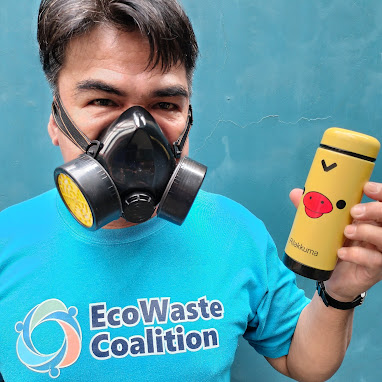Warning Out on Cute But Lead Painted Reusable Water Bottle
The toxics watchdog group EcoWaste Coalition has found another stainless steel water bottle that is coated with dangerous lead-containing paint.
“We are warning consumers not to buy one yellow painted stainless steel water bottle featuring a Rilakkuma-like character,” said Aileen Lucero, National Coordinator, EcoWaste Coalition. “The yellow paint contains over 40,000 parts per million (ppm) of lead that is way above the country’s lead paint standard of 90 ppm.”
The 260 ml. reusable water container measuring 16 cm. tall has the name “Rilakkuma” written on it along with an image of the fictional Japanese character. The group obtained the sample for P100 from a retailer at 999 Shopping Mall in Binondo, Manila. It is not known if the product is an official merchandise or a counterfeit. The box packaging contains information in foreign characters.
Based on the screening conducted by the group using a handheld X-Ray Fluorescence (XRF) analyzer, the surface paint of the said water bottler contained 40,490 ppm of lead.
“Lead is toxic if ingested and young children are most vulnerable to the adverse health effects of lead exposure,” said Lucero. “As a precaution, consumers are advised to immediately stop from using the said lead painted water bottle.”
DENR A.O. 2013-24, or the Chemical Control Order for Lead and Lead Compounds, bans the use of lead in the manufacture of paints and a host of consumer products, including school supplies, to protect human health from lead exposure.
As explained by the EcoWaste Coalition, the lead-containing yellow paint on the exterior of the “Rilakkuma” stainless steel water bottle will deteriorate over time due to regular use and wear and tear of the product.
"The lead on the paint may end up being ingested by a child and posing a health and safety hazard," the group warned.
According to the Global Alliance to Eliminate Lead Paint (or the Lead Paint Alliance), "many children who ingest smaller amounts of lead may not have immediate acute symptoms but may be still at risk of behavioral problems, poor school performance, and lower IQ later in life."
“(Children's) nervous systems are still developing and they absorb 4-5 times more lead than adults, which can cause intellectual disability, underperforming at school and behavioral issues,” said the World Health Organization (WHO).
“In adults, lead exposure increases the risk of ischaemic heart disease and stroke. In pregnant women, lead exposure damages many organs but also affects the developing fetus,” added WHO.
As pointed out by the WHO, "lead is toxic and is harmful to everyone” and "young children are most vulnerable," noting "there is no safe level of lead exposure."
To avoid lead exposure, the EcoWaste Coalition has again reminded consumers, especially adults, to be inquisitive and vigilant when buying painted items such as reusable water bottles, school supplies and toys, and select items that are certified as “lead-safe.”
-end-
Reference:
https://chemical.emb.gov.ph/
https://www.who.int/images/






Comments